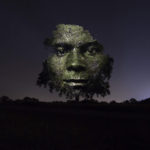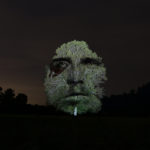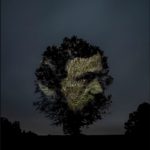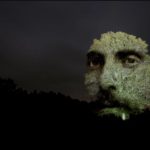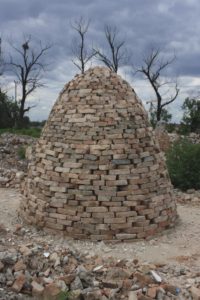Faculty Highlight: Jeff Beekman
Associate Professor Jeff Beekman
Department of Art
Interview by Victoria Salgado
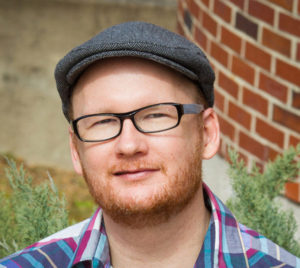 Jeff Beekman, you work with a variety of mediums and processes. Which one was your introduction to art and art creation?
Jeff Beekman, you work with a variety of mediums and processes. Which one was your introduction to art and art creation?
My undergraduate degree is in ceramics. Before that, I took a ceramics course in high school and from there on, it’s all I ever wanted to do. I never wavered in college. I didn’t have any exploratory period where I wanted to do anything else. [I didn’t do very well in it—I got a D.] I found it tough, but I also found it interesting, like I couldn’t figure it out. Art had this different language that I couldn’t understand and it bugged me that I couldn’t understand it.
How did you get into working with mediums like drawing, photography, and digital projection?
It’s a long path. I was going to be a potter. That’s all I wanted to do, even through undergrad, and then I had a pretty bad back injury. I remember I almost dropped out of school, but I only had one year left. Long story short, I came back, but I just couldn’t make the work I wanted to make anymore and that forced me to do other things. I started making figurative sculptures and that got me into graduate school. I said I wanted to get accepted on the strength of that work, but I didn’t want to be beholden to making work like it in the future. Weirdly, they just said, “Sure!”
That’s how I ended up in New Mexico. I took a 2-semester class, but in the second semester, that’s all you took. It was a joint project between the University of New Mexico and the University of Texas. We essentially traveled all around the Southwest in vans and visited sites of historic, artistic, or ecological importance. We literally camped and made work; when you have that, you realize all your tools are gone. I think that that is probably the biggest shaper of how I started thinking of artwork after that. Everybody that was a part of that program radically changed the way they worked. I think it screwed everyone up in productive ways. That’s when I got into photography as a record.
Would you ascribe that time in New Mexico as a formative experience? How do you work as an artist? Do you prefer to work in the studio or do you adapt to whatever environment it is that you’re in?
It changed everything. I learned that I didn’t need a studio. I’ll use a studio, but I don’t go there to make work. I make work and if it happens to be something I need a studio for, I’ll use it, but I don’t have the same relationship to it other people do. There’s been years of my life where I haven’t had a studio.
I think I’ve been forced to adapt quite a bit. In graduate school, I always had my studio, right? That was sacred, you always had to have that, but then when you’re on the road, you can’t do that. After graduate school, I bounced around, I had a lot of jobs. I taught for three years in Gallup, New Mexico at a little tribal school. It was predominantly Native American and I taught ceramics and sculpture there, which is really weird—teaching Native Americans how to do ceramics. It was challenging, but amazing and interesting.
I had a job at Georgia Southern University and that was where I got into teaching Foundations, which is what my role is here: Foundations Director. I’d never actually taken a drawing class before. I remember my very first semester at Georgia Southern had me teaching both Drawing 1 and Drawing 2, along with Art Appreciation. The fourth class was something else, I don’t remember what. I’d never taught a lecture course before, but for the record, four classes are a tough load already for anybody. I just worked really, really hard and had to learn how to teach. Eventually, I lost that job because the economy tanked in 2008. In 2009, they let everyone in my rank go and basically said, “We have no job for you.”
Then I got the job at the University of Oklahoma, which I was there for four years. I did get a studio then, but I found that I worked just as much in it as out. I was hired strictly to help run their Foundations program—that’s largely what I do here now—but it all came from this desperation in not having ways of working. To get jobs, have a livelihood, move forward, and also just be an artist, you have to work with what you have. When I was Georgia, most of my work was made in my bedroom. I had a big bedroom, I put a table in there and that was it.
How did you balance a new teaching role with a really full course load and being an artist?
You just didn’t sleep. That was it. You knew what you wanted. There are periods where you go through productive times and periods where you don’t. I think generally I was really productive because I knew that I wanted something different, not to coast by after getting the job. I worked hard and was constantly applying to shows. I go through periods where I do a ton of research, then I make a whole lot of work, and then I disseminate it. I spent a lot of time just applying to shows, packing the work up, sending it out. I’ve never been good at constantly making new work while those other processes are going forward, so I have to write things up. That’s the sequence for me. Just had a big moment where I pushed a lot of work out, had a variety of shows, and now I’m going back to the drawing board and thinking about new ways to work.
How do you know when a work is finished? How do you decide when it’s time to put it out into the public eye?
When it starts to feel a little more honest. When it starts to feel like you’re honing in on what you want to say through the work. There are so many failures along the way. There are so many moments where you’re stumbling around until you find something that’s interesting, then you approach it from a thousand different directions, and then you figure out how to actually get it to say what you want to say. I think we’re all our worst critics. I mean, you have to be, right? There’s a certain moment where it feels like, “This is beginning to approach what I’m trying to say.” You can never get it perfect, but at the same time you get really close. What we see in our work is oftentimes this string of compromises and imperfections, but it gets close enough to feel like I’m not totally disappointed in it.
What’s flattering is when other people don’t see that. They just see what it’s doing, what it has, and not where it’s fallen off the mark. I guess I’m pretty pragmatic about it, too. There’s a certain point where I am always making work, and I always think about how that folds back into the work I’ve already done: “Are these related? Is this going off in another direction? Do I have time for that other direction?”
How do you negotiate that critical, perfectionist eye with audience expectations and fitting it into the context of your previous work and such?
I don’t really think much about audience beyond myself. “Is this fascinating? Is it interesting? Am I doing something? Am I curious about it? Do I want to keep moving further?” We’ve got the most amazing jobs in the world, right? We get to talk about something we love and get to do things we love, and we can usually figure out how to get other people to pay us for these weird, random projects and ideas we get in our brains. That’s a real privilege. I count myself really lucky. I know how awesomely fortunate I am to have this and hang out with people that are ostensibly interested in the same thing that I am and that’s really cool. In terms of audience, I don’t really think about it too much. At a certain point, I always now think about my mom who is in her 80s—a very smart and generous woman. I want to communicate to her in a way that doesn’t dumb down my ideas, but that she can grasp hold of and communicate with. With the way I talk about the work, I don’t ever talk over anybody’s heads. If I have to take them up to there, I make sure there’s a clear path. That’s the most I accommodate in terms of subject matter.
Do you take on that negotiation in your artist statements?
In my writing, yes. Hopefully, it’s accessible. Those are meant for a more general audience. When I have talks and things like that, I’m pretty plain-spoken. I have all this historic precedence, I know all my artistic lineages, but unless I’m talking to the right audience, it never comes out.
- “Battlefield” Project
- “Battlefield” Project
- “Battlefiel” Project
- “Battlefield” Project
What sparked that interest in the Civil War?
The Civil War stuff really came out of the work in Italy. In Italy, I thought I was going to go do something like I did in China, taking the bricks from the rubble field and building a whole variety of structures. After that, I went to Italy. Because they just had an earthquake in Sicily where there was supposedly still damage around, I’d propose doing work with the materials there and they said, “Yes, that sounds great.” About a week before I arrived, they said, “Oh, by the way, the whole area’s been deemed archaeologically significant and so therefore you can’t do anything with the landscape.” It was a surprise. That’s how I ended up trying to take these photographs and use the projections so I could begin to lay information in. That’s how all that work began. That work was pretty. It got really good reception when I was trying to send it out to places, but it just didn’t feel honest. I didn’t really feel a connection to this place, it was just something I did and experimented with to keep my brain and my hands moving, you know? But when I got back to the states, I had this technology that I wanted to make work through and I roved it around a lot of different ideas. I was doing all this work with waterways in north Florida and that’s when I came across this idea with some of the battlefield work and these sites of negotiation, rather than sites of trauma.
When I was an artist-in-residence at Gettysburg, I got interested in my own family lineage. My family, especially my mom’s side, has always been super proud of their being southerners—there’s a lot that you shouldn’t be proud of with that. I discovered when I was up there that three of my great-great-great-grand uncles all fought at the place that I was staying, about less than a half mile down. I was staying on the battlefield and they fought for the Confederacy, of course, but it was interesting to see those family ties. I have to admit that it really did change my perspective. I’d imagined somebody with ties to the situation and what that must’ve been like. I’m usually pretty critical of people who feel like they have a connection to a land that I’ve never been on before, but something about it, I began to understand.
What would you consider the most challenging part of that project and the least challenging?
Probably the most was getting permission. It’s an awkward conversation when you cold call someone and say, “I’m an artist and I’d like to have access to your facility at night,” in a site where one of the biggest challenges they have is people coming in and trying to find and steal artifacts, right? If I’m being honest, I don’t really like it when other people are around me when I’m working either. When you add all that in, there were a lot of people who didn’t respond. When I did find that first person, they saw that I was serious—I actually called in twice and sent in incident reports on other people scouting and I think that helped. The superintendent of that park ended up being a reference for me when I applied to other places and that helped pave the way.
The other part that’s hard is: It’s easy when you have a generalized statement about wanting to explore those parts, but it’s a little tougher when you cross the next threshold and actually use it to be critical about the present. All art, even though it might be rooted in the past, is really about today—you look at those dialogues and how we’re tripping over the same ideas. This work predates a lot of the negotiation around Civil War memorials, but you can’t go to these places without seeing the mythologizing of these figures, especially up in Virginia, Pennsylvania, even Charleston. These are areas that have pretty dark histories, but there’s always this strategic nostalgia that gets in the way of honest conversation about what happened and what was at stake.
It was really good to be able to make all that work and then go to a place like the Air Force Academy and talk to cadets. I was pushed and challenged, but at the same time, I also think that was actually one of the best audiences I’ve ever had for it. They understood it more intimately. They’re in this place where they’re openly questioning, but their beliefs have been calcified and they’ve already committed to being part of this force.
Easy part is when you’re physically there—that’s the fun part.
What would you say is at the heart of your work? Looking across all the projects and exhibitions that you’ve done, what would you say is the central message?
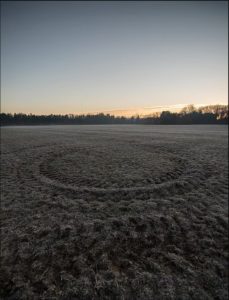 I have themes that I keep coming back to. I think a lot about land, history, and spaces that we occupy. I ask questions about land’s ability to hold on to our past and history. We’re definitely, indelibly leaving our mark on it, but at the same time, it doesn’t care, right?
I have themes that I keep coming back to. I think a lot about land, history, and spaces that we occupy. I ask questions about land’s ability to hold on to our past and history. We’re definitely, indelibly leaving our mark on it, but at the same time, it doesn’t care, right?
It’s about this negotiation of human interactions and relationships in these sites. I keep trying to understand how, where, and what we’re doing. Those are some of the bigger issues we’re wrestling with: land and memory—how they’re strategic and faulty, how these areas become sites of battle, in both historic and contemporary terms, about who controls access and meaning. Why does anyone care that there’s a big statue in a courtyard? Yet there are people who die over those things because of symbolic value. You go to these spaces now and they’re designed to be totally innocuous. They’re not even about real things. It becomes this “unavoidable” conflict between “well-meaning sides” and this “heroic” struggle between the “great individuals.” They might talk about slavery, but you never really get a sense of the visceral nature of it. I’m more interested in the grit and the grime—the fact that in this land, somebody died. You look back at pictures and realize that someone could’ve walked across this entire field and stepped on nothing but bodies of humans and horses that died in the cavalry.
You realize that certain sites became, for instance, where the first tanks were used in the US. All these histories begin to pile up and go over. Now it’s considered hallowed ground, but what’s less sacred than a bunch of men killing each other? It’s ridiculous. You have these reenactors there and that complicates things. When you go to some of these organized sites, they have all these pressures to satisfy demands from tourist markets to keep sites relevant. I’ve been looking at a lot of the places that haven’t been kept up—that, to me, becomes even more interesting because you realize it’s strategic what’s preserved. Who has access to that and why have these other sites not been kept up? That really complicates narratives.
How would you describe the evolution of your art practices, from before the early 2000s to now in 2019?
I did ceramics and pottery. I made brown pots, talked a lot about human touch and the intimacy of it—you use body analogies a lot to talk about the construction of these vessels.
It was largely a video class that changed everything. I realized it was another language where, amazingly, I could make something really quickly, which is something I couldn’t do in ceramics. Then, I became interested in photography as a way to record these performances that I started doing. Collaborations push you in all sorts of directions you thought you never would have gone.
What have been some of your most interesting collaborations?
I was invited as a visiting artist over in Newcastle, England. Someone runs a press there, and he specifically wants to work oftentimes with non-printmakers to make these series editions. The print series we did was really interesting; it was more experimental drawings.
I also went to New Zealand for a collaboration with all these Māori wood carving students. We took a great gallery space and essentially made this giant forest out of cardboard. That was fascinating because I literally lived in another country with a totally different pedagogical model. It was wild.
Probably the one that was hardest and most interesting was in Braddock, Pennsylvania. Braddock, at the time I went there, had lost about 50% of its population due to the closings of steel mills and various drug epidemics. Anybody who could leave, left. A lot of the people there were stuck—this is at a time where there were no restaurants and a lot of the schools had shut down. So, I collaborated with this artist group called Transformazium. I wrote the grant to help create the Braddock Dome. We were basically given the grounds of an old middle school. We separated some of the materials out. We took the dirt and we mixed it, sieving it to get all the larger particle sizes. We made a dome out of concrete, just some small percentage of Portland cement and wire. The whole area ended up being a large community garden because there was no fresh produce in the area at all. This was a way that people in the community could go in and raise their food. This actually became a prototype for the Konbit shelters, which are post-earthquakes shelters in Haiti; they went in and actually helped rebuild a town using this.
When you’re collaborating with other people, how do you negotiate disconnects due to different objectives and ideas?
It can be tough. You have to get excited about the collaboration and the project. You have to realize no one’s making their own work. I try to use radical positivism and keep the right mindset open.
Since you possess a variety of skills that you can choose from, how do you decide which mediums and processes you’re going to use for a project?
It’s the idea. I miss the days where I was a potter because I didn’t have to know what I was doing—I’d show up to the studio and start making. That’s not the way I think anymore.
Do you come up with the idea first, then decide what is going to fit that concept the best?
Yes. Sometimes it’s a process: “This is an interesting material, what can I do with it?” Usually, I just come out of that. I don’t have loyalty to a specific process anymore. That’s why this job is perfect, because I’m not in digital media, painting, sculptures… It only matters that I get my work out. It took me a long time to find a job that was that general.
Is there an artistic tool that you value so much you can’t live without it?
No. That’s what the experience of being on the road taught me. The camera’s pretty important, but it also isn’t the end all, be all. I might’ve said my expensive camera, right? But now you can get good photos with your phone.
I think the internet’s pretty hopeful. There’s such a vast repertoire of different ideas and processes that are so easily at your disposal.
Do you tend to get inspired randomly or do you have to prime yourself before you start working?
I prime myself. It’s the evolution of little successes or things you find interesting. One of the biggest projects I did that opened 2 years ago is probably closer to how I’m thinking about work now. This is all about land. How we use land, abuse land, how these notions of artists change in relationship to land. A lot of the core ideas here are what I’m wrestling with now. The Anthropocene is a buzzword, but at the same time, it’s true. Our biggest existential threat right now is climate change. I’m interested in how the arts can begin to talk about that in a way that becomes about solutions or swaying audiences. I think a lot about that. Probably one of the biggest things is how they wrestle with those.
Is your work now geared towards changing public perception of issues like climate change, and including a call to action that would motivate audiences to act?
It is getting more political. I have a couple of different series going on and I’m definitely exploring more. I’m still interested in Negro Fort. I haven’t been able to access it recently because it closed down because of the hurricane damage. Metaphorically, it’s really fascinating—the idea that in 50 years this site could be swept away. It has an interesting record. I think a lot about that in terms of human history.
Is there a piece of art, exhibition, or publication that you’re most proud of? Why? Are all they all equally important to you in the sense that they contributed something to each era of your life?
Again, I’ve just not been very loyal to any one idea or medium. I’m really serious about the process of making, but I’m not committed to only making one thing. There are certain people where you can see a direct lineage, but that’s never been me. I’ve always let—had to let—situations inform my practice.
Some of the older works, like the latex self-portraits, are really important. That series, in particular, was really tough. I realized I could actually use them as a vehicle to talk about other things, but they hurt a lot to make.
The Hutong structure is one where I essentially just had that portrait and I sculpted it as perfectly as I could. I photographed the entire process and it became this video. This work was really tough and interesting. I was hospitalized in the middle of it—the air quality was so bad. That’s also when I realized I work best if I can just go and focus really hard for a concentrated amount of time rather than just devote two hours here, an hour there. I have a 2-year-old now so that changes everything. I have to figure out ways to compartmentalize it. I can’t be selfish and take off. I was in China once for two months but I don’t have that luxury anymore.
How do you negotiate your personal and professional responsibilities with making the actual art?
It’s super tough. With relation to some of the Battlefield and D-Day work, I had to go and just spend 2 weeks here, 3 weeks there, a week there. I just had to have these intense times where I was selfish and shut everything out. I was able to renegotiate my teaching load to have a semester of no teaching, but I still had all the service responsibilities—I was still Director of the Foundations program. The agreement was that I had to come back for the meetings, but the rest of the time I was up in northern Virginia. Then I got a residency there, so I stayed for about a month straight. Now I’m picking up destinations that are a little closer to home, things like the Negro Fort, the Natural Bridge. But I don’t have an easy answer. If you let it, the other responsibilities will fill up as much time as possible and you also want to spend time with your kid.
Do you go to your studio daily? Do you have a daily routine that you adhere to?
I try. Unexpected things happen. Some are totally predictable: If you’re teaching Tuesdays and Thursdays, it’s harder to squeeze things in, so Mondays and Wednesdays, you get everything else in. Over the weekend, you have your kid and other duties. You usually just have to pick out those times and be incredibly selfish.
Summers become really important. Unfortunately, every now and again, you just have to say, “I need this day off. I just need to go document.” A lot of it now is deadline-driven, which is not the best way to make work. But I think as my son gets older, it’ll be different. I won’t necessarily have to be right on top of him. Luckily, we’re in a department with many small kids. A lot of places aren’t like that, so I’m really glad I’m in a place that’s supportive of children, especially since none of us have stay-at-home partners. Everyone’s either a professor or in school somehow.
How did you end up at FSU?
I bounced around a lot. I started teaching in New Mexico and got that teaching job while I was still in graduate school. Somebody quit and they had two weeks to find somebody. They had classes already in the books and students enrolled. I commuted out to Gallup for two years, two times a week. It was about two-and-a-half hours away. They then hired me full-time to run their gallery. When that job dried up, I ended up getting a teaching position in Georgia. Before that, I really thought I was not going to be able to teach anymore—I had a job at a gallery lined up in Santa Fe. But, a friend of mine really pulled strings and helped me get a job there.
I’m from Florida, so I wanted to be closer to family. That’s why I took the job here initially, but when I was in Oklahoma, I felt like there were a lot of decisions being made around me that weren’t always the best for the program. So, I only applied to positions where I felt like I could have a little bit more control over my destiny—that’s why I took this position with the BA/Foundations role. I just got tenure, so I’ll be here for a while. It’s my sixth year at Florida State.
Did you expect to get into teaching and to become a professor?
I didn’t think it was possible. I grew up in a blue-collar family; my mom was a social worker and my dad died when I was two. I was one of six kids. My twin sister and I were both at the very bottom of six. Nobody had money and nobody was an academic. My sister has a Master’s in Education and she’s an elementary school teacher.
I remember talking to friends in my MFA. They were the first ones that actually made me realize, “Wait a minute, maybe this could actually be something for me.” My friend, Megan, felt like a lot more was possible than I ever believed—her mom had been the Chair of a department and her dad was a judge. She said, “Why don’t you go for this? You could.” It never really crossed my mind that being a professor was something that somebody like me could do. I think about that a lot; I was very fortunate to run into somebody like that.
How would you describe your teaching practices?
They’re totally driven by what I see the students needing. I created a couple of courses since I got here, but one of the most important is the Contemporary Foundations class. It largely came out of students not knowing enough about contemporary art and not getting it through other means. With help, I created this course that’s meant to get incoming freshmen a crash course in contemporary art in a very robust way. We’d had nothing like that before. Normally, this content should be going through Art History. They require that you take Survey 1 and 2, so you start with Prehistory and go to the Renaissance. Then, you go from the Renaissance up to a certain point, sometimes never even past the 60s. If we want students, we have to keep them accountable to this history and train them in this history.
The other course that is really important to me is the BA Exploring Opportunities in the Arts. The whole Foundations program is about taking students from 12 years of compulsory education and helping them to deprogram a little bit. To help them realize the whole art world is a lot bigger, weirder, and amazing than they think it is, but also to help them understand that this is a lineage they could use to become as big and weird as they want to be inside of it. Before, it was very easy to limit yourself, like I did for years with ceramics, and almost try to shut down that other awareness. It’s all about trying to open students up in the BA course, which has evolved a lot from when it first began. It used to be a capstone course—now it’s located in the junior year. It’s meant to get students to be strategic about the end of their career here and to be mindful that they’re going to get out of this place with what they need to move forward. There’s very little discussion about what comes next after an arts education, or the discussion is limited to talking about working in a gallery. It’s hard to make a living in galleries, especially if you’re coming out of Tallahassee. The other option is to do exactly what we did and go to graduate school to become a professor. If that doesn’t work, then what’s left? We want to talk about what the other options are. “How do people who graduate with your degree find ways to make it?” Something that no one had done for me is help me figure out what that was. I gave myself the task of finding out how other people make it in the art world because I didn’t know—I was a product of going to grad school and finding a teaching job. So, I was trying to articulate pathways that I didn’t take.
I’m really proud of what that course is doing now; a lot of students leave here with a good understanding of what they want to do and what it’s going to take to get there. A lot of it is trying to get them to understand the importance of personal work and giving them access to opportunities like internships. But it’s really trying to get students to be proactive and thinking through exactly where they want to go, figuring out what that would look like, and how to get there by reaching out to people. That’s the course I probably get the most students coming back and saying, “That was incredibly helpful.”
A lot of my teaching is like that—I think about where the holes in my education were. If I can make it a little easier on my students, why not? I remember getting out from undergrad and saying, “I have no idea what I’m going to do.” I worked at bars, was a lifeguard, and delivered newspapers. I knew that I wasn’t happy. I think my training and my understanding of what I could do with my degree was terrible. That’s why I liked the BA course and helped that become what it is. It involves a lot of questions, it involves a lot of community outreach, it involves creating as many forums as possible for other people to come in and speak to your students. It’s about getting students to be exposed to lots of alternative vantage points and to instill an ethic more than anything else—this ethic of: “I’ve got to work hard, but I have a direction on how to get there.” I think the Foundations program has evolved to holistically make students interesting and thoughtful, to help them become what they can be. You’re not going to do that by delineating a path they have to follow; it’s more about presenting lots of opportunities and letting them chart.
As a professor and artist, what is the most vital lesson or idea you want to instill in students?
I think it changes with the level. I think a lot of that early education is trying to deprogram, get excited, and also see that there are rewards in these explorations.
On their way out, I think more about: “If education is preparatory, what’s the preparatory tour?” If our job is to help students prepare for a future and we don’t help them articulate what that is for themselves, we’re doing a disservice.
With the graduate students, they made this decision—out of all the places in the world to go—to come study with you. You talk to them more about your work, being honest, learning how to shut other people out, taking what’s valuable, and learning how to ignore the rest of it. Graduate school is this compressed time where you have a rare opportunity to just focus on your work. I feel like I differ from other people in that I want to clear out a lot of those other obstacles and let them just focus on their work.
I think it’s important to be true to your own voice, unleash your understanding, and be able to kick an idea in a thousand different ways to hopefully make rapid development, which is always stressful. You can grow 10 years’ worth of work in a period of 2 years, right? You’re able to have the time, but it’s never a comfortable situation. Part of my job is directing the majority of the graduate teachers—they’re instructors in the Foundations program, so you also talk to them about that. Just because you’ve taken a lot of classes doesn’t mean you understand the other side. Being a teacher is really different. A big thing that I think about is slipping out of that mindset into learning how to get in front of a classroom, command attention, and read a situation. Students are as complicated as anyone else, right? One of the biggest mistakes I find beginning instructors doing all the time is compartmentalizing and thinking about them one way. All of us have these complex, amazing, wild stories. You don’t always have access to them, but if you approach teaching with an understanding that these people have complicated histories and your job is to help them leverage it or do great things in spite of it.
